I had never really visited the Netherlands before, aside from some family vacations when I was 11 or 12, so I had some expectations but very little solid knowledge of what to expect. There are of course a number of stereotypical views of the Netherlands among English-speakers such as myself, including windmills, dykes, and Amsterdam's red light district. I saw all of those things, and I'll write about them in more detail in planned upcoming posts, but before my trip I hit upon a slightly different theme for my vacation: big engineering. The Dutch have a long history of taking on really large, landscape-scale improvement projects; about half the country is very close to or below sea level, and famously the people of the Netherlands have claimed some fairly large chunks of seafloor for themselves as land to live on. I have an odd sort of fondness for really big engineering projects - dams, bridges, road networks, et cetera - and this small country seems to teem with such things. In the end, I discovered a more general category of Dutch achievements, beyond the list of Dutch Big Engineering.
I flew to Amsterdam's Schiphol Airport via Minneapolis/St. Paul on June 30, a total trip time of somewhat more than 11 hours. That's not hugely impressive by international travel standards, and I was lucky enough to have two seats to myself on the longer 8-hour leg over the Atlantic. Travelling east, I have found I need to squeeze two days into a period considerably less than 48 hours long; this means I need to sleep for at least a few hours even if I'm not particularly sleepy. I was able to catch about 4 hours of sleep that short night, in two roughly-two-hours-long blocks. I was pretty tired upon landing, but overall OK as far as jet-lag was concerned.

Somewhere over eastern North America, just before my Delta flight served dinner.

Close to the Dutch coast, a taste of things to come: an impressive array of offshore wind turbines, and a fleet of what I assume to be ships tending the turbines - they were showing no wakes, so I think those ships were waiting nearby, for what purpose I do not know. Other ships in the area (Rotterdam is a very, very busy port and is not far away) were showing clear wakes from our altitude when I took these pictures.
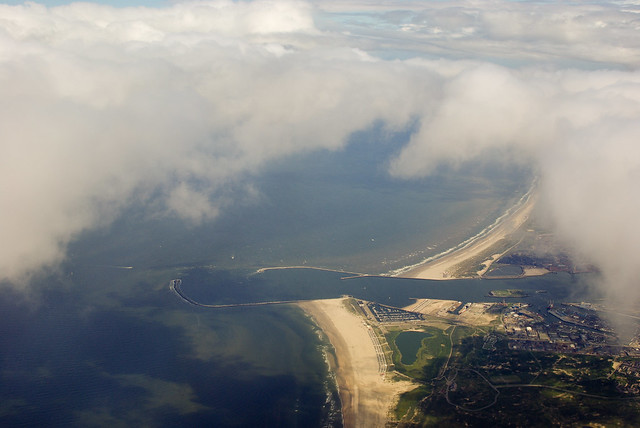
The North Sea entrance to the Noordzee canal that links Amsterdam to the ocean.
Customs at Schiphol was fairly disinterested in my visit, and I was through with my baggage rather quickly. As is typical for my visits to Europe, I got on the wrong train at first, but some friendly fellow-passengers were happy to help me out, and after waiting about 10 minutes at the Amsterdam-Zuid train station I was on the correct train to Nijmegen*. Rather than attempt to navigate the surely-excellent local public transit, I just took a taxi to the hotel where the workshop and conference would be held. It was in the taxi that I first met an interesting difference from my expectations: the driver's English was very good, but he would frequently pause and admit he didn't know a word. Unlike my trip to Norway last year (which I still haven't written up, or edited very many photos, ugh I'm bad at this blog thing sometimes), the people of the Netherlands are good at English, rather than perfectly fluent (better than many native speakers) like the Norwegians. I do not want to suggest that the Dutch don't speak English, but at the population level the level of English fluency in Norway was higher. In Norway, people spoke to me in English first more than half of the time, and switched instantly when it became apparent I knew no Norwegian if they started in that language. In the Netherlands, people talked to me in Dutch, and in many cases did not switch to English if I was not perfectly clear about my ignorance of their language (for short interactions, like paying for things in a shop, I relied on the "smile and nod" method). In both countries, I was flattered and a bit embarrassed that so many people were willing to accommodate me; I feel somewhere between unfairly privileged and decadent when I travel in places with such a high level of English-as-a-second-language skill - I feel a bit guilty that I have to make no effort at all to be understood even when so far from home.
* Weirdly, my spellchecker (Open Office Writer v. 3) suggested the word "Nitrogen" when it encountered "Nijmegen"; the conference was about the nitrogen cycle.
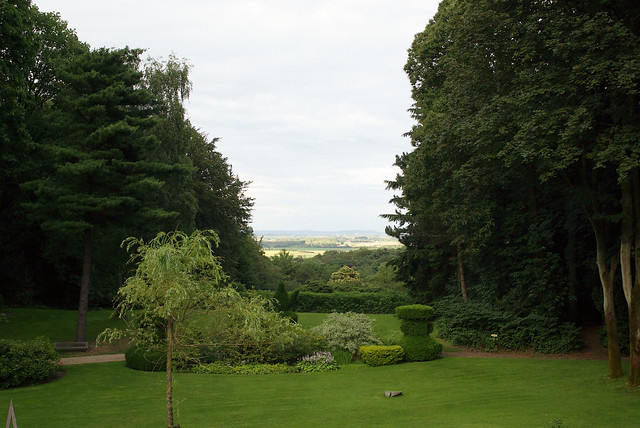
The view from the terrace (terras) of the Golden Tulip Val Monte hotel. Such a view, from an elevated place overlooking a valley, is quite rare in the Netherlands, and in fact the distant ridge-line is in Germany.
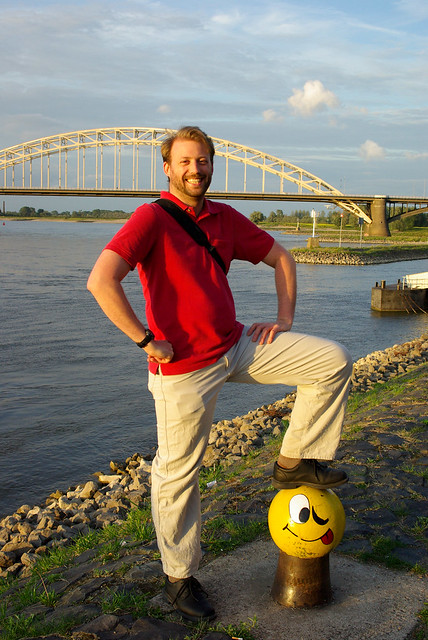
We went on a guided tour of the town of Nijmegen one evening at the workshop, and because I like bridges one of my fellow attendees offered to take my picture in front of this one. "Captain Morgan" occurred to me here.
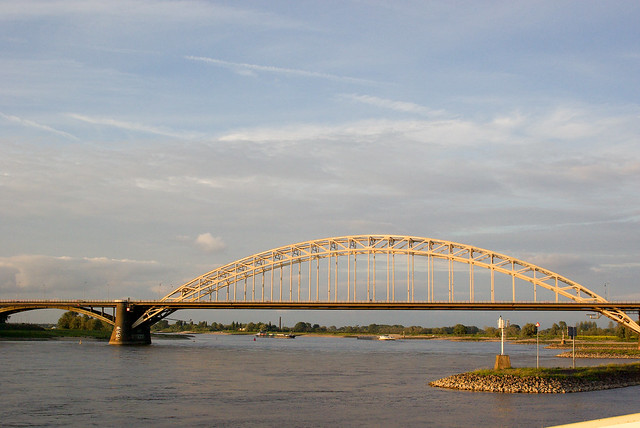
Another look at the Nijmegen bridge, over the river Waal, without me goofing off in front.
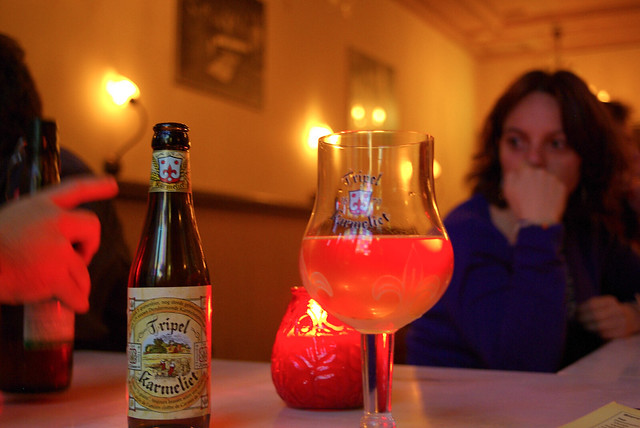
The tour ended at a local pub, which served a wide variety of very, very good beer. I went for one of their Belgian imports.
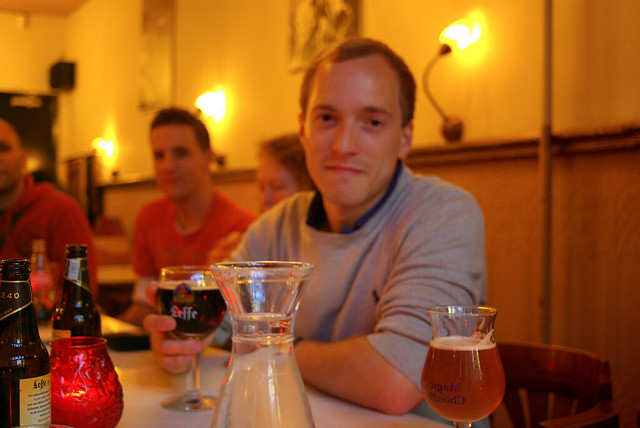
Bram is from Belgium, so he was satisfied with the choice of bar, rather than excited as I was.
I'll talk more about the workshop for early-career scientists and the conference in an upcoming post. The last day (and day of my talk) was Thursday, July 7. After the late-afternoon closing remarks, a group of us travelled to Amsterdam. Three of my companions had flights back to North America from Schiphol the following morning, but one other, Andy's flight wasn't until Saturday morning, so he and I found a hostel room to split and see as much of Amsterdam as we could on Thursday night and during the day on Friday.
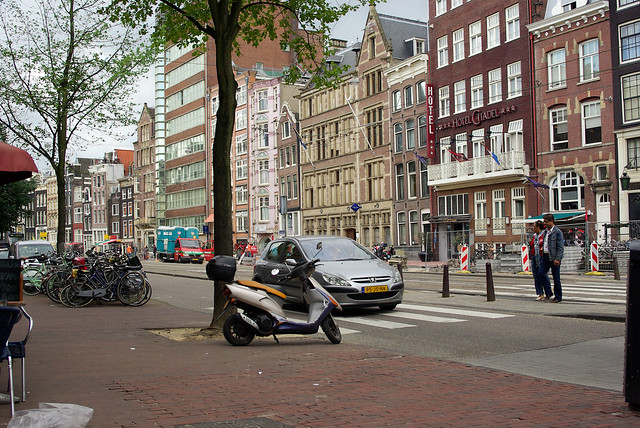
Taken from a table where Andy and I ate pannekoeken in Amsterdam. I really like the continental European tradition of open-air cafes on the sidewalk in the cities and towns (at least when the weather is good).
Speaking of cafes, there's a bit of a special vocabulary when talking about places to eat and drink in the Netherlands. The term "coffee shop" is reserved for places that really only sell coffee as an afterthought; these are the places that sell marijuana in various forms (smoke-able, sometimes pre-rolled, or baked into various foods). "Cafe" actually means a place that really has more in common with a pub; they usually sell only a few varieties of sandwiches or similar quick foods, but have a variety of beers and will serve mixed drinks and wine. A pancake house (Pannekoekenhuis) serves a fantastic selection of Dutch-style pancakes (thin, very often savoury rather than sweet, suitable for lunch and dinner as well as breakfast), but are actually not particularly common. Tea houses (Theehuis - sometimes Dutch really is very easy for an English-speaker) are uncommon, but do serve food. Basically, "lunchroom" comes closest to an English word for a place that sells lunch-type foods. And I still don't really know what to call a place like Starbucks (maybe Koffiehuis?).
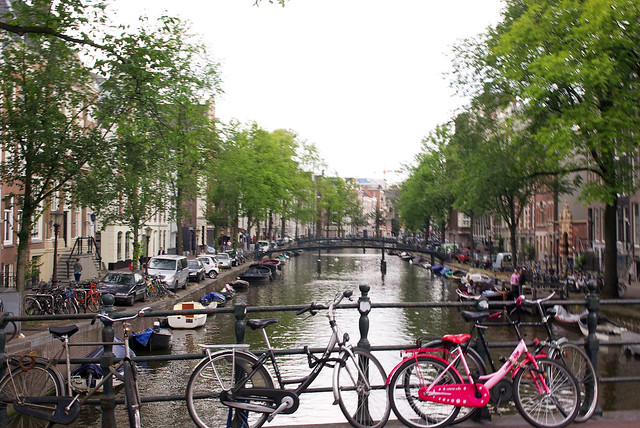
Bicycles, canals, bridges - this is Amsterdam, but in fact could be any one of a great many Dutch towns. I was told Amsterdam wasn't "really Dutch", but it did have some features that were very stereotypical of the country.
I picked up a rental car at Schiphol airport on Saturday morning, travelling with Andy to the airport first thing in the morning. In my driving around the country, I discovered a surprising (to me) diversity of landscapes. I was expecting almost uniformly to find crowded towns separated by high-intensity agriculture on very flat, quite wet ground. Such terrain certainly exists, and probably accounts for a large majority of the Netherlands' territory, but there were many other places to see, as well.
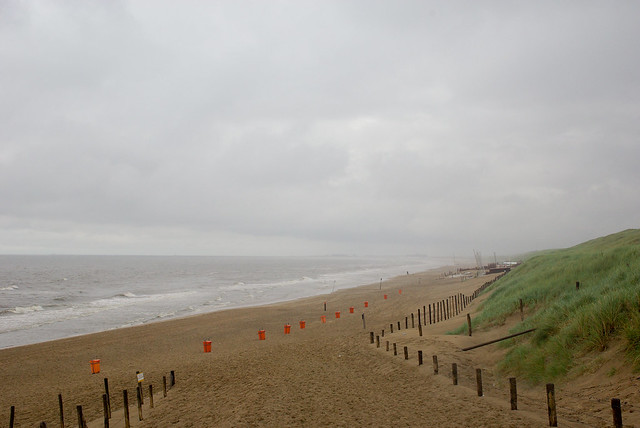
A view along the beach to the northeast at Zuid-Kennermerland National Park, on the North Sea just south of the Noordzee canal.
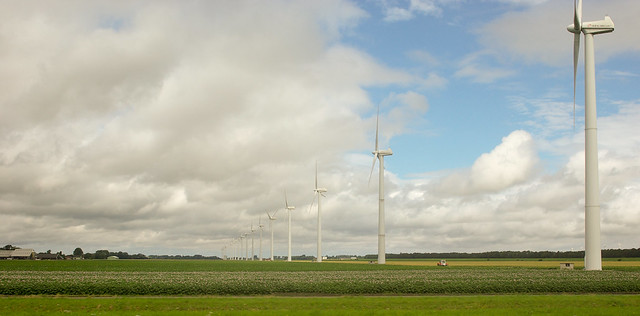
The modern (I would even venture to say "futuristic") incarnation of the classic Dutch structure: windmills! Actually wind-turbines, but windmills is a more fun word to say. Northern provinces (Noord-Holland and Fryslan, especially) are covered with thousands of these. Some people don't like the way these look, but I think they're great.
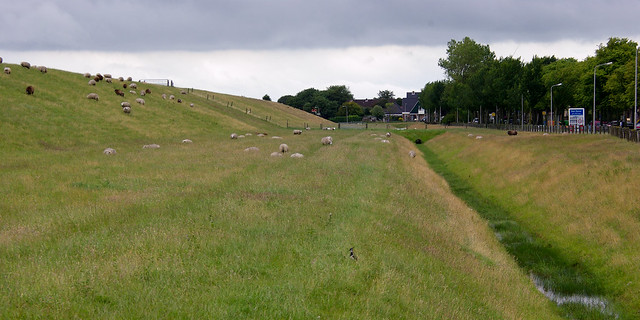
I was told sheep are grazed primarily on the sides of the dijks (I prefer the Dutch spelling) to control the grass and prevent destabilization of the structure.
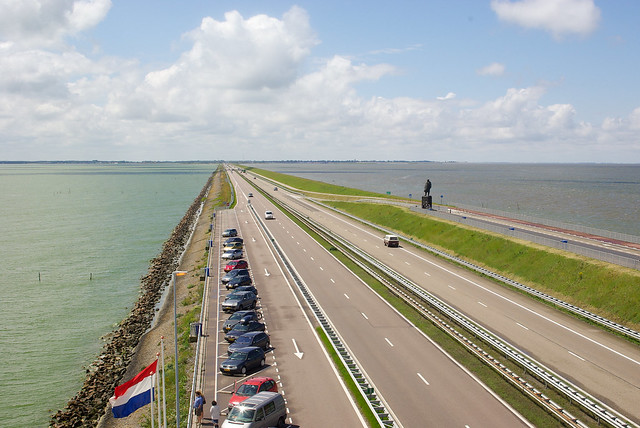
A view from the monument facilities near the middle of the Afsluitdijk, one of the Big Engineering projects I'd explicitly set out to see. I have to admit I went full-tourist at this place, and bought several cheesy souvenirs, including a 5-cent piece pressed with an image of the Afsluitdijk by turning a big crank.
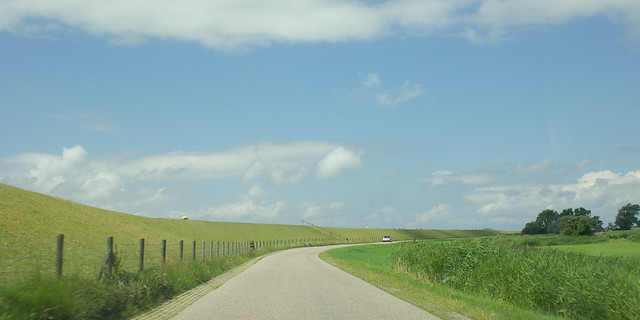
Roads often run either along the top or next to the dijks. This one was fairly typical - speed limit 60 km/h, and looking to me as a single lane but with two-way traffic, plus bicycles. Passing anything but the narrowest oncoming traffic required me dropping my right-side wheels into the grass.
Roads like the above are the main reason I was so surprised to see so many really big American cars in the Netherlands - Chrysler and Chevy are significant portions of the Dutch car market. As someone who drove a Dodge Caravan for more than seven years, I find the sight of such vehicles on Dutch roads to be mind-blowing. I didn't take very many pictures from the driver's seat inside the towns, mainly because I was too busy watching out for bicycles and pedestrians while squeezing down narrow lanes, and I was driving a fairly small car! I saw many quite new Chevy Z71 pickups, Chrysler minivans, and Jeep Grand Cherokees, all of which are wide enough to have rubber on both edges of the pavement on some roads.
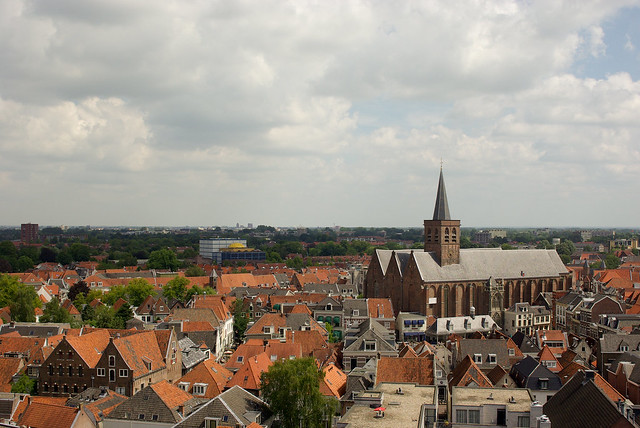
Amersfoort, what I came to think of as a typical Dutch town. The old town center, several hundred years old, is surrounded by layers of newer development. Some towns have had some rather severe urban renewal in their cores (either by warfare, especially in the strip of the country most directly affected by Operation Market Garden in 1944, or by demented city planners in the 1970's and 1980's), but many (most?) have intact old town centers.
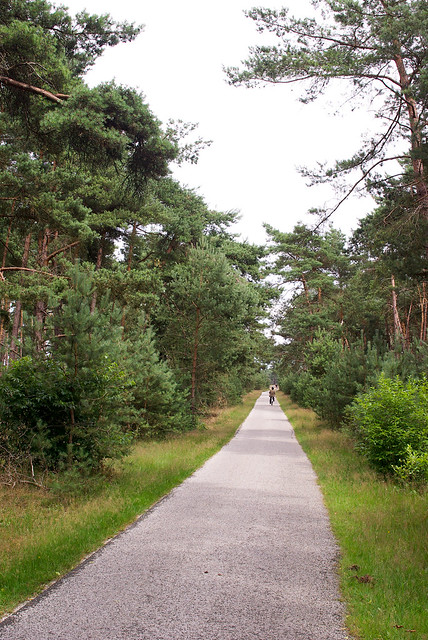
Hoge Veluwe National Park, another surprising landscape of sandy soil, dry woodland, heath, and some dunes.
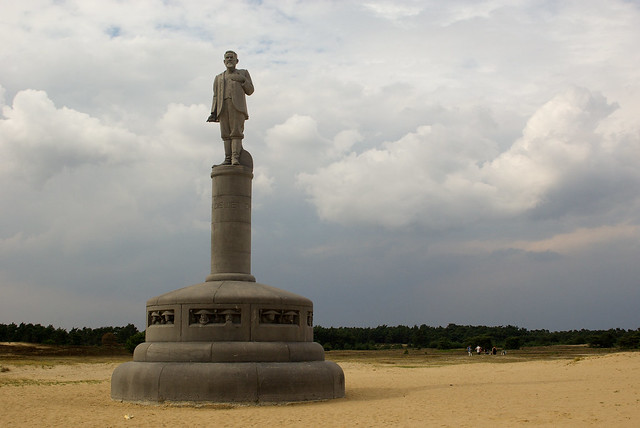
A statue of Christiaan de Wet, prominent general on the Boer side during the Boer war in South Africa in 1899-1901 (also known as the Three Years War) and briefly a president of the Orange Free State. This was a surprise find in Hoge Veluwe, for a number of reasons. I'm planning a post about the national parks I visited, so I'll talk more about this statue then.

A lift-bridge on the way into the old town center of Den Bosch (the full name of the town is 's-Hertogenbosch, which I managed to pronounce correctly once).
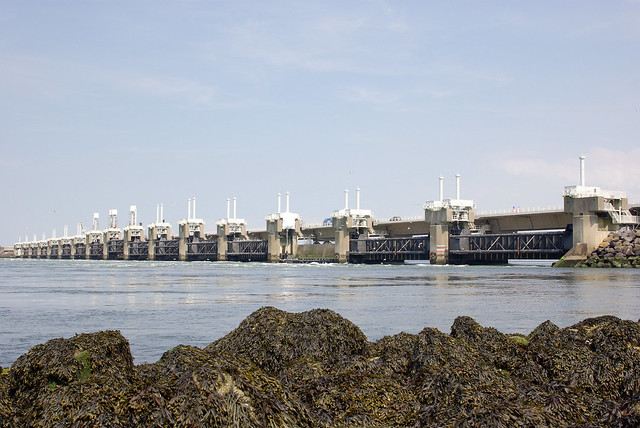
The Oosterscheldekering, largest of the storm surge barriers that, along with dijks, dams, and other structures, constitute the Delta Works. This is the other Dutch Big Engineering project I'd set out to visit before my trip.
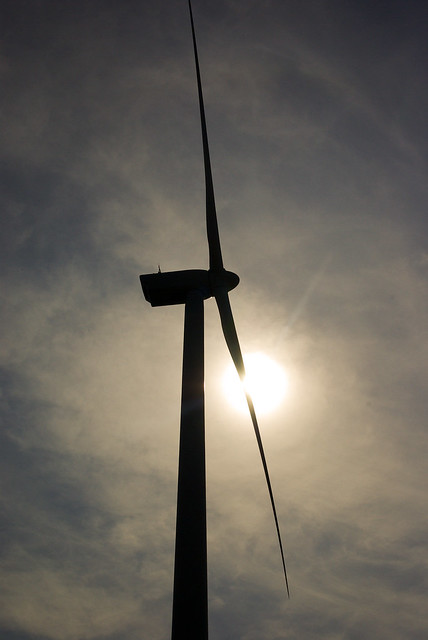
A windmill at Oosterschelde National Park, not far from the Oosterscheldekering. There were no barriers or restricted access to this one, so I was able to get right up to it. I'm pretty happy with this picture.
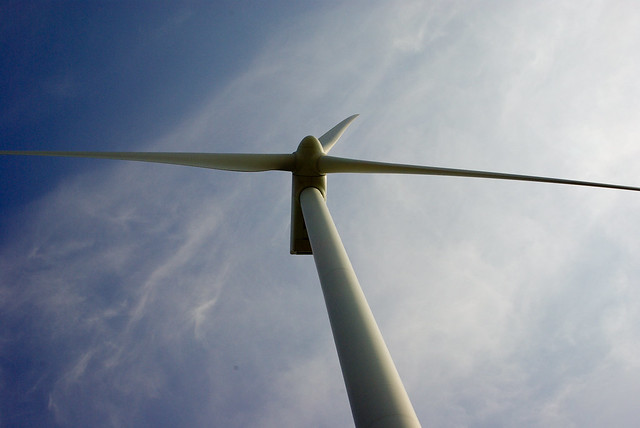
Another view of the same windmill. The windmills especially became part of my realization that I admire many Dutch achievements, beyond just the terrific examples of large-scale landscape management.
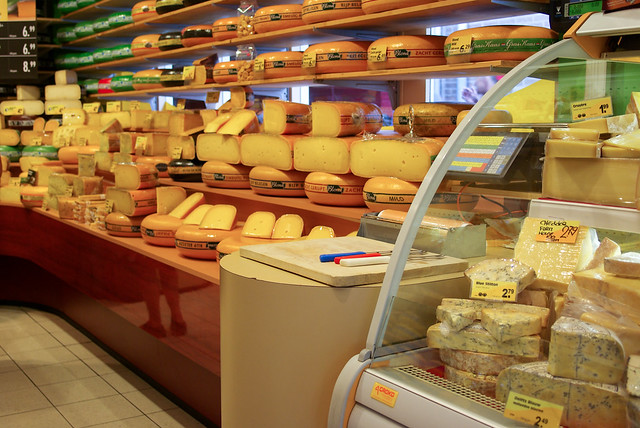
A cheese shop! I love cheese, and so do the Dutch.
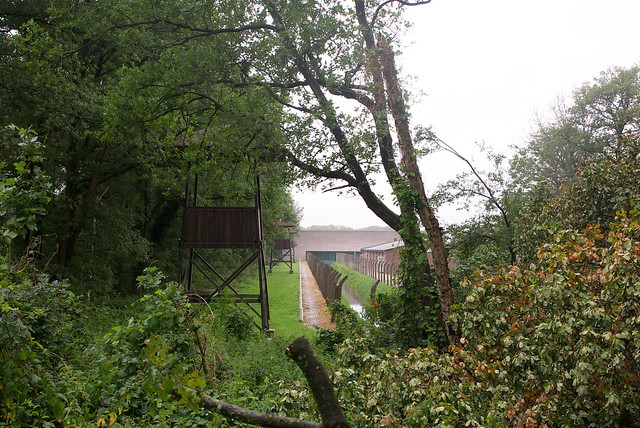
A surprising find of a much less pleasant sort: part of the remains of Kamp Vught, a small concentration camp ('only' 31 000 prisoners over 5 years) from the German occupation of the Netherlands in World War II. I had thought all of the Jews and other "undesirables" captured by the Nazis in the Netherlands had been deported to camps in Germany or further east, but this camp was operated as a forced-labour camp and was every bit as horrible as the rest of the Nazi "final solution". The Dutch experience of the Second World War was quite different from that of any English-speaking country, due to their total occupation by Nazi Germany and the resulting... well, everything. I'll need to think about this some more before I can write about it intelligibly.
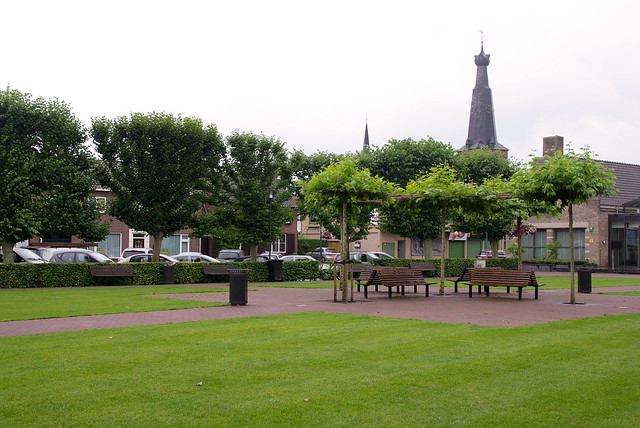
Obligatory bench shot. Almost every semi-serious photographer I have talked to is a big fan of benches, both as subjects of photos and as a nice place to rest during a long day of photography. There are many benches in the Netherlands.
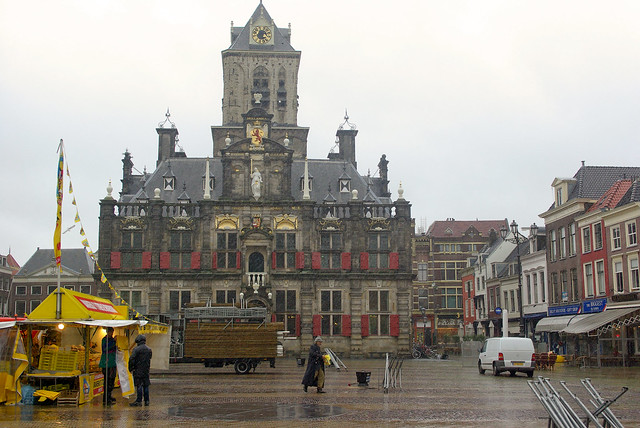
The Stadhuis of Delft. I had wanted to visit this town because of its excellent museums and general reputation as a very pretty and very Dutch place. It was difficult to evaluate these claims, because I could not find the museum I most wanted to visit, and it rained heavily all day.

Cheese! This is a ball of boerkass (literally, "farmer's cheese") that I bought from a roadside stand, along with some cherries to eat in the car, in Zeeland after visiting some of the Delta Works. Bringing it back into Canada caused a bit of trouble with customs, but in the end they let me bring it home. I haven't yet decided if I will eat it a little bit at a time with nearly every meal, as the Dutch do, or as a special occasion, perhaps with a bottle of wine.
I've got several posts planned, and about 1400 more pictures to sort through, for my Dutch vacation. The very short version is: I had a truly excellent time, and I very much want to return.


9 comments:
Hi Martin, Nice to read about your experience in our little country with big engineering!
You got me thinking about the koffiehuis (Hard to imagine we have topics that weren't discussed thoroughly enough). I guess traditionally coffee was never taken outside of the house. It is a drink the Dutch take at home or when visiting family and friends at their house. Sharing time to drink coffee is considered to be a fun thing to do and is associated mainly with social interactions (lekker bakkie koffie, gezellig). And of course, 10h and 15h are not to be missed coffee times at the work environment. Maybe you have noticed that the places where you can get coffee only (so no option to get alcoholic beverages, like at a café), were mainly companies from abroad that opened shop in the Netherlands. I presume this is why there is no proper word for the place where you get only coffee or tea. Luckily the café does supply you with warm beverages :)
Maybe now you can imagine why the kletskop is called kletskop, as it is taken with coffee and over coffee you talk and share stories.
Let me know when you're going back and I'll go with you. I think we would have the same trip and take totally different things away.
Ruth
Let me know when you're going back and I'll go with you. I think we would have the same trip and take totally different things away.
Ruth
arg! gmail!!
Hey, sorry for taking so long to comment on this post - I thin I remember it going up right in the middle of my whole 'interviews around the country followed by difficult decision' period.
I've always had a very strong desire to visit the Northern European Dutch/Scandinavian countries, partially because they appear to be highly progressive (which I appreciate) and it seems to be very easy to get around in English (esp. in Sweden). Your photos reaffirm my desire! I've got at least one really good friend from Sweden, actually, and she's invited me to come visit, so I may take her up on that when I recover from my big, upcoming move.
On a side note, you're very lucky that you get to go to international conferences. One of the big drawbacks to postdoc-ing here at the NIH is the total ban on travel to int'l conferences (the one exception is the ability to go to Canadian conferences IF the conference is being hosted by an American-owned society), which is MURDER for someone in evolutionary biology such as myself (the biggest evo meeting are frequently outside the US). This doesn't even have to do with costs - it's ok to fly to San Diego (3000 mi) but not Toronto (600 mi) except as noted above.
One thing that I've learned is the value of meeting people all over - it actually becomes important in the later stages of your career, and I wish now that I'd done a better job of keeping in touch. Never too late to change one's ways, I suppose.
Oh, it also totally slipped my mind to mention that another thing for which you are lucky: Here at the NIH, it's absolutely against government ethics rules to tag vacation onto a 'business' trip. A contracted company books your flight in and out, making sure that you're there for the minimum required time ;-(
Fabulous photo's Martin, can't wait to see more. How about a Sunday trip West.
Love MOM
Liesbeth: I had an absolutely fantastic time in your little country, with the big engineering and the people with big hearts. And the many fine places that served coffee and many other things.
Ruth: I want to go back right away, but alas, I don't think I'll get back across the Atlantic for a while. I agree, we'd certainly take different things away (though I suspect you would have also brought back semi-contraband cheese!)
Carlo: I've got lots more to say about this, but you're absolutely right, my two trips to northern Europe have confirmed they are excellent places. And you're right about how lucky I am regarding international conferences and tacking vacations onto those trips. Thanks Steve, it really means a lot!
Mom: More photos coming soon. And I should be able to put together a drive westwards sometime before the end of the summer - Alberta has its own free ferries, too!
What a treat! Much text, many pics and the sudden realization that you saw far more of the Netherlands in 2 weeks than I ever did when I lived there for a few months. And the line about the little country full of people with big hearts is what I remember, too. There's something very endearing about Northern Europe, as Carlo says: progressive, liberal, organized, open-minded... with impeccable brewing and cheese making techniques!
Post a Comment